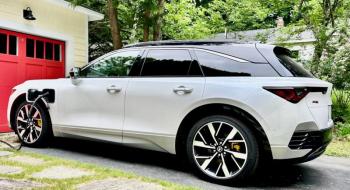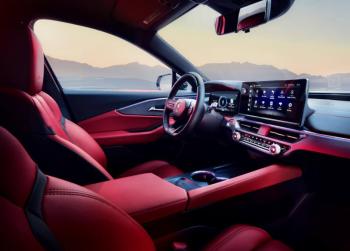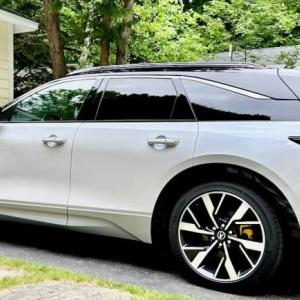Stealth Bomber: Acura ZDX Type S
 Long, low (for an SUV), sleek and spacious, the head-turning ZDX nonetheless qualifies as a mid-size vehicle. The premium Type S shown here has an electric motor on each axle, with a total of 499 horsepower, and rides on an adaptive air suspension and 22-inch wheels with 6-piston Brembo front brakes. This color is Snowfall Pearl with Seamless Black.
Long, low (for an SUV), sleek and spacious, the head-turning ZDX nonetheless qualifies as a mid-size vehicle. The premium Type S shown here has an electric motor on each axle, with a total of 499 horsepower, and rides on an adaptive air suspension and 22-inch wheels with 6-piston Brembo front brakes. This color is Snowfall Pearl with Seamless Black.
 The ZDX is a deluxe vehicle, designed and equipped to make driving, or crawling along in rush-hour traffic, comfortable, convenient and safe. A Bang & Olufsen audio system with 18 speakers and 14 channels of amplification is standard in all models. The stalk sprouting from the steering column is the gear selector lever. Connectivity is intuitive and easy. Unlike touchscreens in Acura’s other SUVs, this one is not haptic—buttons and icons don’t give slightly under finger pressure.
The ZDX is a deluxe vehicle, designed and equipped to make driving, or crawling along in rush-hour traffic, comfortable, convenient and safe. A Bang & Olufsen audio system with 18 speakers and 14 channels of amplification is standard in all models. The stalk sprouting from the steering column is the gear selector lever. Connectivity is intuitive and easy. Unlike touchscreens in Acura’s other SUVs, this one is not haptic—buttons and icons don’t give slightly under finger pressure.
 Long, low (for an SUV), sleek and spacious, the head-turning ZDX nonetheless qualifies as a mid-size vehicle. The premium Type S shown here has an electric motor on each axle, with a total of 499 horsepower, and rides on an adaptive air suspension and 22-inch wheels with 6-piston Brembo front brakes. This color is Snowfall Pearl with Seamless Black.
Long, low (for an SUV), sleek and spacious, the head-turning ZDX nonetheless qualifies as a mid-size vehicle. The premium Type S shown here has an electric motor on each axle, with a total of 499 horsepower, and rides on an adaptive air suspension and 22-inch wheels with 6-piston Brembo front brakes. This color is Snowfall Pearl with Seamless Black.
 The ZDX is a deluxe vehicle, designed and equipped to make driving, or crawling along in rush-hour traffic, comfortable, convenient and safe. A Bang & Olufsen audio system with 18 speakers and 14 channels of amplification is standard in all models. The stalk sprouting from the steering column is the gear selector lever. Connectivity is intuitive and easy. Unlike touchscreens in Acura’s other SUVs, this one is not haptic—buttons and icons don’t give slightly under finger pressure.
The ZDX is a deluxe vehicle, designed and equipped to make driving, or crawling along in rush-hour traffic, comfortable, convenient and safe. A Bang & Olufsen audio system with 18 speakers and 14 channels of amplification is standard in all models. The stalk sprouting from the steering column is the gear selector lever. Connectivity is intuitive and easy. Unlike touchscreens in Acura’s other SUVs, this one is not haptic—buttons and icons don’t give slightly under finger pressure.
Two weeks ago, our review of the ADX, the newest member of Acura’s now four-vehicle SUV stable, may have planted the notion that they all look alike. Not so: the MDX, RDX and ADX clearly have the same parentage; it’s equally clear that this ZDX must have been adopted. Its three siblings look businesslike, functional and mildly truck-y; the ZDX is a head-turner.
Acura being Honda’s upscale brand, all four of its SUVs were designed in Honda’s California studios. But the ZDX, Acura’s first EV, doesn’t have the usual internal-combustion-engine powertrain under the hood, which allows stylists freer rein—and, as it happens, the ZDX actually was adopted.
It is built on General Motors’ modular Ultium EV platform. So the ZDX (and its less-expensive Honda analog, the Prologue, which we drove last September) shares its underpinnings with a dozen electric GM vehicles, from the Cadillac Lyriq and Celestiq to Chevrolet’s battery-powered Equinox, Blazer and Hummer. Sharp-eyed drivers may spot a few GM switches in the ZDX cockpit, but otherwise Acura has done a first-class job of creating a fresh-looking and upscale two-row, 5-seat wagon.
The ZDX is available with rear-wheel drive and a 358-horsepower motor (starting at $65,850 including destination fee) or with all-wheel drive and two motors, one on each axle, good for a combined 490 horses starting at $69,850. Our top-of-the-line Type S is also a two-motor AWD, but tweaked to 499 horses and 544 pound-feet of torque. With a $600 upcharge for fancy paint plus the $1,350 destination fee, its MSRP comes to $75,450.
Acura reserves the Type S badge for its higher-performance vehicles. With this much power—electric, so it’s available near instantly—and four driven wheels, the hot ZDX accelerates like a silent bullet. But despite its adaptive air suspension and a Sport driving mode, it’s no agile slalom ski. Instead, with three tons of mass and its battery bank set low in the floor, it is something of a downhiller, a firmly planted cruise missile, solid-feeling and smooth and ready to break the horizon.
One-pedal driving—regenerative braking—is available and the force can be adjusted on the touchscreen. (BTW, even without touching the brake pedal, when the driver lifts off the ‘gas,’ the rear brake lights come on.) Dynamics aside, the Type S also has upgrades such as 16-way power-adjustable front seats with extra bolstering, a panoramic power sunroof and a heated steering wheel with electrically adjustable rake and reach. These are on top of a long list of standard luxury appointments.
Mains: Along with Apple CarPlay, Android Auto and built-in Google, standard on the ZDX Type S is AcuraWatch 360, which uses an updated forward-looking camera and new millimeter-wave radars in the front and on all four corners. This enhances the standard AcuraWatch suite of safety and driver-assistance features with Active Lane Change, Lane Change Collision Mitigation and Front Cross Traffic Alert. All together, these systems also enable hands-free driving on about 400,000 miles of compatible, scanned highways. Across the ZDX lineup, the adaptive cruise control and lane-keeping assist have been made more responsive and smoother, and the blind-spot monitors now can see farther behind.
Incidentals: Upon start-up, the ZDX can’t be shifted out of Park until the driver’s seatbelt is buckled. And the sing-song pedestrian-alert sound that the also-electric Honda Prologue makes at low speeds is present here too, but it’s less discernable inside—either my hearing has deteriorated since last fall or Acuras are better insulated than Hondas. (The latter, I hope.) But bystanders can still hear a ZDX bearing down on them.
According to Acura, a fully charged rear-wheel-drive ZDX has a range of about 315 miles in warmer weather; on the more powerful and heavier AWD Type S, the range drops to about 278 miles. A week of driving seemed to back up these figures. Every ZDX has fast-charging capability, and buyers and leasers can choose one of three charging packages included in the MSRP. These offer combinations of public charging credits, charging equipment and a credit toward home installation of a fast charger. Furthermore, every ZDX is eligible for the $7,500 federal tax credit—so far, anyway.
Next week: Subaru Solterra




























